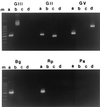Development of rRNA-based PCR assays for identification of Burkholderia cepacia complex isolates recovered from cystic fibrosis patients
- PMID: 10488171
- PMCID: PMC85518
- DOI: 10.1128/JCM.37.10.3167-3170.1999
Development of rRNA-based PCR assays for identification of Burkholderia cepacia complex isolates recovered from cystic fibrosis patients
Abstract
PCR assays targeting rRNA genes were developed to identify species (genomovars) within the Burkholderia cepacia complex. Each assay was tested with 177 bacterial isolates that also underwent taxonomic analysis by whole-cell protein profile. These isolates were from clinical and environmental sources and included 107 B. cepacia complex strains, 23 Burkholderia gladioli strains, 20 Ralstonia pickettii strains, 10 Pseudomonas aeruginosa strains, 8 Stenotrophomonas maltophilia strains, and 9 isolates belonging to nine other species. The sensitivity and specificity of the 16S rRNA-based assay for Burkholderia multivorans (genomovar II) were 100 and 99%, respectively; for Burkholderia vietnamiensis (genomovar V), sensitivity and specificity were 87 and 92%, respectively. An assay based on 16S and 23S rRNA gene analysis of B. cepacia ATCC 25416 (genomovar I) was useful in identifying genomovars I, III, and IV as a group (sensitivity, 100%, and specificity, 99%). Another assay, designed to be specific at the genus level, identified all but one of the Burkholderia and Ralstonia isolates tested (sensitivity, 99%, and specificity, 96%). The combined use of these assays offers a significant improvement over previously published PCR assays for B. cepacia.
Figures


References
-
- Burdge D R, Noble M A, Campbell M E, Krell V L, Speert D P. Xanthomonas maltophilia misidentified as Pseudomonas cepacia in cultures of sputum from patients with cystic fibrosis: a diagnostic pitfall with major clinical implications. Clin Infect Dis. 1995;20:445–448. - PubMed
-
- Campbell P W, Phillips III J A, Heidecker G J, Krishnamani M R S, Zahorchak R, Stull T L. Detection of Pseudomonas (Burkholderia) cepacia using PCR. Pediatr Pulmonol. 1995;20:44–49. - PubMed
-
- Gillis M, Van T V, Bardin R, Goor M, Hebbar P, Willems A, Segers P, Kersters K, Heulin T, Fernandez M P. Polyphasic taxonomy in the genus Burkholderia leading to an amended description of the genus and proposition of Burkholderia vietnamiensis sp. nov. for N2-fixing isolates from rice in Vietnam. Int J Syst Bacteriol. 1995;45:274–289.
Publication types
MeSH terms
Substances
Associated data
- Actions
- Actions
- Actions
- Actions
- Actions
LinkOut - more resources
Full Text Sources
Medical
Molecular Biology Databases

